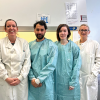Scientists have developed a technique that allows them to measure how well cancer drugs reach their targets in the body.

It shows individual cancer cells in a tumour in real time, revealing which cells interact with the drug and which cells the drug fails to reach.
The findings could potentially help clinicians decide the best course and delivery of treatment for cancer patients.
Researchers at the Francis Crick Institute and Imperial College London developed the means to measure and visualise drug-target engagement of individual cells within a tumour, using a miniature fluorescent microscope.
Using their technique, they mapped out how the chemotherapy drug doxorubicin targeted ovarian cancer cells in living mice.
They found significant variation in drug-target engagement between cells within a single tumour, and between different tumours.
They also found that drug-target engagement was better when doxorubicin was administered via abdominal injection rather than intravenously – the currently preferred method for doctors treating patients in many clinics.
Erik Sahai, senior author, said: “Our findings show that in a mouse model with delivery of doxorubicin through the blood, it does not reach all its target cells in the body, which could help explain why this chemotherapy drug is only partially effective in some cancer patients.
“In contrast, delivering the drug directly into the abdomen adjacent to ovarian tumours improved its target engagement, but this was still not sufficient to kill the cancer cells.”




